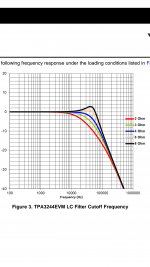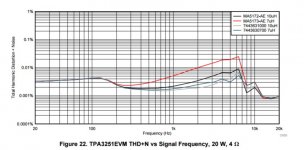Hi,
Yes, tonally it is a little sparkly but it reminds me of Yamaha's Natural Sound amps so it's not a problem - just a surprise - and maybe modifying the output filter will change the tonal balance? I'd rather not get a different EVM.
Actually, I wondered if I had connected up the transformers in a non-ideal way, not having used them before. The input is se, and I didn't connect ground from input to the centre of the output, and I also didn't use the centre tap on the amp side. Experimenting/learning/ignorant... ;-)
Yes, tonally it is a little sparkly but it reminds me of Yamaha's Natural Sound amps so it's not a problem - just a surprise - and maybe modifying the output filter will change the tonal balance? I'd rather not get a different EVM.
Actually, I wondered if I had connected up the transformers in a non-ideal way, not having used them before. The input is se, and I didn't connect ground from input to the centre of the output, and I also didn't use the centre tap on the amp side. Experimenting/learning/ignorant... ;-)
Last edited:
Hi,
Yes, tonally it is a little sparkly but it reminds me of Yamaha's Natural Sound amps so it's not a problem - just a surprise - and maybe modifying the output filter will change the tonal balance? I'd rather not get a different EVM.
Actually, I wondered if I had connected up the transformers in a non-ideal way, not having used them before. The input is se, and I didn't connect ground from input to the centre of the output, and I also didn't use the centre tap on the amp side. Experimenting/learning/ignorant... ;-)
It's worth experimenting with loading of the transformers as well. A 20K pot across the secondary could help you dial this in.
I hesitate to mention this, but I have had an apparent improvement in sound (reduced sibilance) on other Class D amplifiers, by removing the aluminium heatsink.
The heatsink resonates mechanically and I believe this couples into the audio circuitry.
The architecture of the TPA3251 and TPA3244 are similar, but the TPA3244 EVM doesn't have an aluminium heatsink...
(ran out of time to try removing the heatsink ftrom the TPA3251EVM, maybe someone can try this and report back?)
Hi,
Thanks for the tip - how exactly is the pot connected up? I'll definitely give it a go. The no heatsink mod sounds a bit foil hats but I'll try it too.
I tried different connections today. Centre tap on the secondary connected to gnd on the amp shuts the amp down with an orange led to tell me I've been a silly boy. Centre tap on the secondary to signal ground on the SE primary sounds better, and the amp is fully silent with zero volume. However, connecting / disconnecting different sources can trigger a red fault light.
Thanks for the tip - how exactly is the pot connected up? I'll definitely give it a go. The no heatsink mod sounds a bit foil hats but I'll try it too.
I tried different connections today. Centre tap on the secondary connected to gnd on the amp shuts the amp down with an orange led to tell me I've been a silly boy. Centre tap on the secondary to signal ground on the SE primary sounds better, and the amp is fully silent with zero volume. However, connecting / disconnecting different sources can trigger a red fault light.
Last edited:
maybe someone can try this and report
From own recently made measurements, the heatsink may have an impact on stray coupling between the power/output path due to shaping the magnetic coupling field. This measurements weren't done on an EVM, so YMMV. Also the influence is pretty small, i doubt anyone would hear this, but who knows.
Centre tap on the secondary connected to gnd on the amp shuts the amp down with an orange led to tell me I've been a silly boy.
Isn't this a full short of the input carrying a DC voltage ?
Hi,
Thanks for the tip - how exactly is the pot connected up? I'll definitely give it a go. The no heatsink mod sounds a bit foil hats but I'll try it too.
I tried different connections today. Centre tap on the secondary connected to gnd on the amp shuts the amp down with an orange led to tell me I've been a silly boy. Centre tap on the secondary to signal ground on the SE primary sounds better, and the amp is fully silent with zero volume. However, connecting / disconnecting different sources can trigger a red fault light.
Haha funny yep foil hats were mentioned when I suggested it! We both heard the difference between the 3251 and 3244.
Just wire the pot as a variable resistor (connect pin 2 to pin 3) and connect it across the transformer secondary - I would use a linear pot for this.
Cheers,
Mike
Opamp decoupling Vmid for tpa3244evm is more extensive than for tpa3251evm and tpa3244evm has ceramic inputcapacitors, but probably more differences there 😀
Isn't this a full short of the input carrying a DC voltage ?
Almost - trafo has DC resistance and there is a series resistor between the amp and trafo but its clearly not enough to limit current.
Haha funny yep foil hats were mentioned when I suggested it! We both heard the difference between the 3251 and 3244.
Just wire the pot as a variable resistor (connect pin 2 to pin 3) and connect it across the transformer secondary - I would use a linear pot for this.
Cheers,
Mike
Thanks - I was wondering about using a zobel but I'll try the pot first...
Opamp decoupling Vmid for tpa3244evm is more extensive than for tpa3251evm and tpa3244evm has ceramic inputcapacitors, but probably more differences there 😀
Plus the output filter has higher value caps and inductors and I expect this is the main factor? Pairing with speaker impedance? See fig 3 in the evm datasheet.
Attachments
Last edited:
The 7uH TI picked has higher distortion than 10uH version, so they picked the 7uH and added graphs to LC filter design app note showing why the highest distorting value was chosen ? Doesn't make sense, they mixed-up labels probably, if relevant at all.
They picked the 10uH for the 3244 and 7uH for 3251 and I guess this is because they expect people to test the higher power evm with lower impedance speakers, not because of small differences in distortion. If that were their priority, they would have chosen the Wurth parts, but given compromises elsewhere on parts, their aim is not ultimate performance but a suitable test bed at a given cost.
EVM is for testing with resistors, not speakers. Was it made for speakers 7uH would not have been chosen, imo.
Find a speaker that has 4 ohm impedance at 70.000 Hz, I think finding one below 30 ohm would be a lucky catch 🙂
Find a speaker that has 4 ohm impedance at 70.000 Hz, I think finding one below 30 ohm would be a lucky catch 🙂
ICYMI the amp has a thread here:
http://www.diyaudio.com/forums/clas...-design-compact-size-amazing-performance.html
TI say that the lower value inductors typically have lower distortion because of fewer windings on the same core. So I reckon that the graph is incorrect.
- Home
- Amplifiers
- Class D
- TPA3251d2

